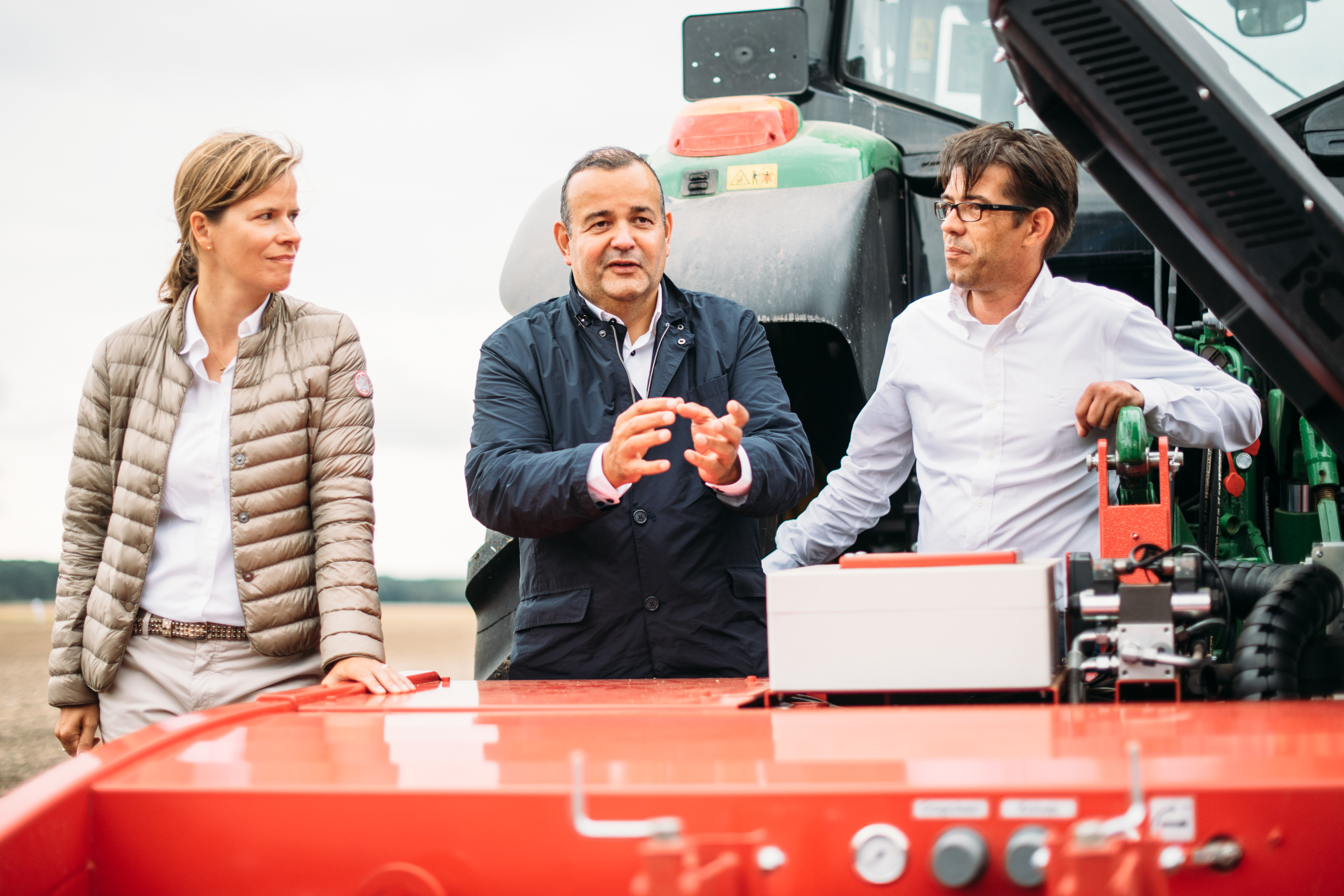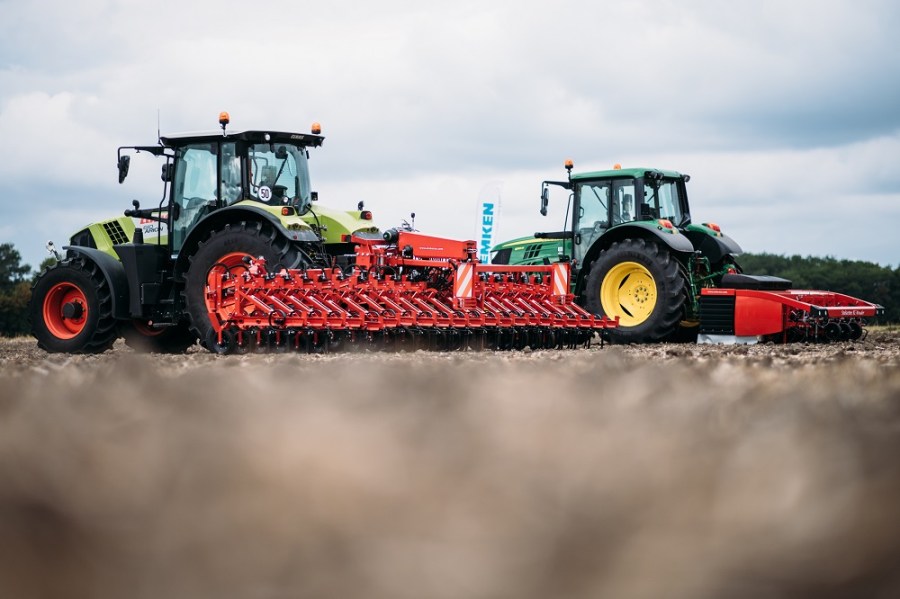At an international press event near Paris last month, Lemken set its sights firmly on a data-driven future, and revealed a surprise purchase. CPM looks at the digital products on offer and reviews what’s new in traditional lines.
Digitalisation will change the industry. It’s not an option and it’s more than a reality – it’s a necessity.
By Tom Allen-Stevens
A runway has just lit up on the clipped parkland overlooked by Château de Charbonnière in the Loire Valley, France. At the end are two tractors, their headlights dazzling the world’s agricultural press who have gathered on the château’s terrace, invited to a dinner, hosted by Lemken, and here to see the big surprise reveal.
As the tractors come towards the puzzled audience and then peel off left and right, it’s the implements they carry that tell the story. Lemken has acquired the hoeing technology specialist Steketee, based in the Netherlands. The plan is to expand its crop care product portfolio with implements for mechanical weed control and camera-assisted machine control, and it’s two of these which come to a carefully choreographed halt beneath the terrace.

The acceptance of chemical crop care agents is decreasing, says Anthony, both among farmers and within the broader society.
The purchase of this specialist company is an important addition in view of ongoing change in the crop care segment, says Lemken managing director Anthony van der Ley. “The acceptance of chemical crop care agents is decreasing, both among farmers and within the broader society. At the same time, resistance against currently available active substances is continually increasing, while hardly any new substances are coming onto the market.
“With legal requirements becoming more and more stringent, we therefore need effective alternatives.”
Anthony sees herbicides as the area of chemical crop care products offering the greatest potential for reductions in use, which is why mechanical weed control and hoeing technology has now been added to Lemken’s product range.
Headquartered in Stad aan’t Haringvliet, Netherlands, Steketee employs about 50 staff. Its proprietary camera technology supports farmers in controlling their machines precisely and guides both conventional hoeing between crop rows and hoeing between plants within a row.
There are plans to expand the company’s Dutch facilities and build on its existing manufacturing capacities. Existing staff will be retained, while its parent company, still operated by the German Lemken family, aims to step up sales and accelerate Steketee’s growth. The Dutch company’s soil cultivation division Rumptstad is also in the deal but both brand names will be retained for the time being.
Klaas Veerman, Steketee’s former owner and managing director, will continue to have responsibility for the company’s operative management together with Iljan Schouten, Head of Lemken’s Crop Care business unit.
The purchase of Steketee may be the latest move made by the German manufacturer into Farming 4.0. This is the step that takes use of technology in agriculture beyond mere precision farming and auto-guidance. Digital Farming is seen as the means to go beyond the presence and availability of data. Anthony believes it’s about creating actionable intelligence and meaningful added value from such data.
“Digitalisation will change the industry. It’s not an option and it’s more than a reality – it’s a necessity.”
Lemken is one of a group of manufacturers behind a number of collaborative data-based ventures These aim to make data transfer between different machines and brands seamless. Not only that, the aim is for this to be largely autonomous and done in a way that links to the meteoric growth in devices expected to join the Internet of Things (IoT), such as weather stations
And there’s evidence that, given the right tools and know how, farmers are ready to step up to the digital challenge, says Anthony. He quotes figures that suggest that 53% of farmers use digital applications in line with Farming 4.0, 43% use apps or plan to use them and 45% use high-tech agricultural machinery, or plan to use it. But just 17% use farm management platforms to plan their use, and only 28% make targeted investments in continuing training in digital skills.
“It should be easy and interconnectable. Autonomous robots and driverless tractors will change what’s done in the field. Drones and satellite technology will deliver accurate and precise information. But farmers need universal data management – they need to be able to link up the sources and share the data, and that requires good connectivity, otherwise there’s no point.”
Agrirouter points to a simplified way of working
If ISOBUS is ensuring all your machines are talking to each other, shouldn’t there be a platform to seamlessly relay data? That’s the thinking behind Agrirouter, developed by German start-up DKE-Data and launched at Agritechnica last year, where it was awarded a DLG Silver medal.
The platform is being developed by a consortium of machinery manufacturers, including AGCO, Amazone, Deutz-Fahr, Grimme, Horsch, Krone, Kuhn, Lemken, Pöttinger and Rauch. Hendrik Vennemann of Lemken’s Fieldtronic notes that ISOBUS has substantially improved communications between all the kit from these partners but there’s been a lack of additional standards to ensure the reliable exchange of data.
“The DKE Agrirouter offers a solution to this problem by providing an internet-based platform for the exchange of data across manufacturers that now puts the benefits of digitalisation within the reach of everybody working in agriculture,” he says.
So how does it work? “Users open an account and then decide what connects to it. This may include machines, farm management systems, apps and their developers, farmers, consultants, contract farmers, fertiliser manufacturers and other members of the value chain.”
Data is encrypted and therefore transmitted securely to other applications and partners. “Each user puts together their own personal Agrirouter and defines rules about who exchanges which data with whom to what extent. Famers therefore always determine what happens with their data. Most importantly, that data will be merely transmitted and not stored permanently,” explains Hendrik.
The idea is that, with your data buzzing around in the background between those people you deal with and the machines on your farm, you can get on with the important things, like making decisions. “Many transfers can be automated, and basic settings facilitate operations. It’s a very open system, so if other companies want to come in they can, subject to access protocols the farmer decides.”
The big breakthrough for Agrirouter may come in May 2019 when Next Machine Management is due to be launched. This is set to allow seamless data transfer between six manufacturers (AGCO, Krone, Kuhn, Lemken, Pöttinger and Rauch) and the agricultural software company FarmFacts.
Next connects every machine into a farmer’s production processes, including planning and scheduling orders, legal documentation, field mapping and wayline administration. “The farmer creates a task in the office and the software delivers it to the CCI, or other compatible terminal, in the relevant machine. It will be particularly useful for automated, process-oriented data use, especially for companies with mixed fleets,” adds Hendrik.
With mobile devices, farmers will be able to access their data anywhere and at any time. An additional native smartphone app, which will be available for both iOS and Android, will allow ‘analogue’ machines to use the Next Machine Management module without electronics.
The Agrirouter platform itself is free of charge for users, who ultimately only pay for their individual internet access, for the apps they use, and for mobile data transfers between the hub and agricultural machinery.
The CCI (Competence Centre ISOBUS) terminal itself has also been upgraded. The CCI 1200 has a larger 12in display. “It now has multiple windows, so you can view the sprayer in one window and section control in another. If you have two ISOBUS machines, you can connect both to one terminal,” notes Hendrik.
A set of icons allows easy switching between machines or to an on-board camera, for example, while an integrated mobile connection transfers data to and from Agrirouter.
Fields that talk to you
A new weather station is available from Lemken that gives you detailed information direct from the field to your smartphone, tablet or office PC.
A collaboration with the Dutch start-up Appsforagri, it allows growers to calculate the dew point and leaf wetness, combine this information with additional weather data, and decide the optimal time to spray or cultivate without even visiting the field, says Lara-Antonia Weiler from Lemken Fieldtronic.
“The microclimate in a crop can be very different to conditions around it, and this can affect how disease develops. The weather station gives you accurate information on both. It’s particularly useful for farmers with outlying fields or to assess whether a frost has thawed.”
The weather station is partially buried in the ground and measures the soil temperature at 20 and 5cm depth, and the air temperature and humidity at a height of 25cm in the crop and 75cm above the crop.
These values are transmitted every 30mins to the smart farming app on a smartphone or tablet via the Sigfox low-frequency network. This is claimed to be the largest Internet of Things (IoT) network and currently covers most of lowland England. It allows sensors to transmit data without batteries, although the weather station has a battery, said to last for five years without replacement.
The app can then calculate the dew point and leaf wetness. “It brings in additional reliable official sources to collect data on wind speed and direction, radiation values and rainfall. This aggregate information enables farmers to respond to local climate conditions and to plan their crop care measures with high precision,” adds Lara-Antonia.
The weather station can be combined with a rain sensor that also delivers up-to-date values every half hour. The data collected from the field is stored retrospectively for one year to provide an overview of how the local climate has developed.
A crop care module is also available for additional guidance. This module provides farmers with a 14-day weather forecast and a 5-day disease pressure forecast for over 100 diseases in more than 40 crops.
The weather station is available for sale to anyone via the Lemken online store and costs €199 (£180). The app service is due to go live in Dec 2018 and will cost €27.70/mth (£25) for a three-year contract, including the Sigfox subscription.
BoomCommand, the automatic boom height control developed by Lemken, is set to get smarter. Working with Canadian precision specialist Norac, it’ll allow varying degrees of height and tilt adjustment. Three sensors – one on each boom (pictured) and one in the centre – are used to automatically adjust height and each boom section independently, to follow contours closely. Five sensors, with two on each boom, will adjust for row crops or uneven canopies.




